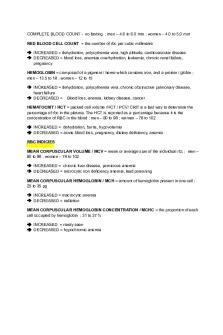Complete Blood Count - Lecture notes 1 PDF

| Title | Complete Blood Count - Lecture notes 1 |
|---|---|
| Author | Bogart Galler |
| Course | Bachelor of Science in Nursing |
| Institution | West Visayas State University |
| Pages | 5 |
| File Size | 121.5 KB |
| File Type | |
| Total Downloads | 305 |
| Total Views | 408 |
Summary
COMPLETE BLOOD COUNT - no fasting ; men – 4 to 6 mm ; women – 4 to 5 mmRED BLOOD CELL COUNT = the number of rbc per cubic millimetre INCREASED = dehydration, polycythemia vera, high altitude, cardiovascular disease DECREASED = blood loss, anemias overhydration, leukemia, chronic renal failure,preg...
Description
COMPLETE BLOOD COUNT - no fasting ; men – 4.6 to 6.0 mm ; women – 4.0 to 5.0 mm RED BLOOD CELL COUNT = the number of rbc per cubic millimetre
INCREASED = dehydration, polycythemia vera, high altitude, cardiovascular disease DECREASED = blood loss, anemias overhydration, leukemia, chronic renal failure, pregnancy HEMOGLOBIN = composed of a pigment / heme which contains iron, and a protein / globin ; men – 13.5 to 18 ; women – 12 to 15
INCREASED = dehydration, polycythemia vera, chronic obstructive pulmonary disease, heart failure
DECREASED =
Blood loss, anemia, kidney disease, cancer
HEMATOCRIT / HCT = packed cell volume /HCT / PCV/ CRIT is a fast way to determine the percentage of rbc in the plasma. The HCT is reported as a percentage because it is the concentration of RBC in the blood ; men – 80 to 98 ; women – 78 to 102
INCREASED = dehydration, burns, hypovolemia DECREASED = acute blood loss, pregnancy, dietary deficiency, anemia RBC INDICIES MEAN CORPUSCULAR VOLUME / MCV = mean or average size of the individual rbc ; men – 80 to 98 ; women – 78 to 102
INCREASED = chronic liver disease, pernicious anemia DECREASED = microcytic iron deficiency anemia, lead poisoning MEAN CORPUSCULAR HEMOGLOBIN / MCH = amount of hemoglobin present in one cell ; 25 to 35 pg
INCREASED = macrocytic anemia DECREASED = radiation MEAN CORPUSCULAR HEMOGLOBIN CONCENTRATION / MCHC = the proportion of each cell occupied by hemoglobin ; 31 to 37 %
INCREASED = rarely seen DECREASED = hypochromic anemia
COMPONENT
NORMAL FINDINGS
INCREASED
DECREASED
WHITE BLOOD CELL OUNT Total number of wbc in a cubic millimetre of blood
4,500 – 11,000
Acute infections Tissue necrosis Myocardial infarction Collagen disease
Viral infections Hematopoletic disease Rheumatoid arthritis
DIFFERENTIAL COUNT Proportion of each of the 5 types of wbc in the sample of 100 wbc
50-70%
Acute infection
Viral disease Leukemia Aplastic and iron deficiency
LYMPHOCYTES
25-35%
Viral infection Chronic infection Lymphocytic leukemia
MONOCYTES
4-6%
EOSINOPHIL
1-3%
BASOPHIL
0.4-1.0%
Viral disease Parasitic disease Collagen disease cancer Allergic reactions Phlebitis Thrombophlebitis Parasitic infestation Leukemia Inflammatory process
Cancer Leukemia Multiple sclerosis Renal failure Lymphocytic leukemia Aplastic anemia
PLATELET COUNT Platelets are basic elements in the blood that promote coagulation
150,000 – 400,000
NEUTROPHIL
Infections Polycythemia vera Acute blood loss splenectomy
Stress, burns, shock Adrenocortical hyperfunction Hypersensitivity reaction Stress Pregnancy Idiopathic / unknown cause Thrombocytopenic purpura Cancer Systemic lupus erythematosus Some types of anemias
SERUM ELECTROLYTES Normal Values Sodium (Na+) 35 - 145 mEq/L Potassium (K) 3.5 - 5.0 mEq/L Ionized Calcium (Ca++) 4.5 -5.5 mg/dL Calcium (Ca++) 8.5 -10.5 mg/dL Bicarbonate (HCO) 24 - 30 mEq/L Chloride (CI) 95 - 105 mEq/L Magnesium (Mg++) 1.5 - 2.5 mEq/L Phosphate (PO ) 2.8 - 4.5 mg/dL
ARTERIAL BLOOD GASES / ABG pH : 7.35 to 7.45 PaO2: 75 to 100 mmHg PaCO2: 35 to 45 mmHg HCO3: 22 to 26 mEq/L
BLOOD CHEMISTRY Total plasma protein 95±12 (10) Albumin 43±7 (4) Globulin 44±17 (4) Alkaline phosphatase (AP)
137±82 (4)
Alanineaminotransferase (SGPT)
81 ± 41 (4)
Aspartateaminotransferase (SGOT) Creatine kinase (CK)
158 ± 44 (4)
116 ± 68 (4)
Gamma-glutamyltransferase (GGT)...
Similar Free PDFs

Blood - Lecture notes 1
- 6 Pages

Blood Banking Lecture Notes
- 12 Pages

Blood vessels - lecture notes
- 21 Pages

Lecture notes - Marketing - complete
- 17 Pages

Lecture notes - Property - complete
- 82 Pages

Complete Lecture Notes
- 47 Pages

Complete Pharmacology Lecture Notes
- 127 Pages

ACF211 - Complete Lecture Notes
- 39 Pages

Lecture notes - Complete
- 28 Pages
Popular Institutions
- Tinajero National High School - Annex
- Politeknik Caltex Riau
- Yokohama City University
- SGT University
- University of Al-Qadisiyah
- Divine Word College of Vigan
- Techniek College Rotterdam
- Universidade de Santiago
- Universiti Teknologi MARA Cawangan Johor Kampus Pasir Gudang
- Poltekkes Kemenkes Yogyakarta
- Baguio City National High School
- Colegio san marcos
- preparatoria uno
- Centro de Bachillerato Tecnológico Industrial y de Servicios No. 107
- Dalian Maritime University
- Quang Trung Secondary School
- Colegio Tecnológico en Informática
- Corporación Regional de Educación Superior
- Grupo CEDVA
- Dar Al Uloom University
- Centro de Estudios Preuniversitarios de la Universidad Nacional de Ingeniería
- 上智大学
- Aakash International School, Nuna Majara
- San Felipe Neri Catholic School
- Kang Chiao International School - New Taipei City
- Misamis Occidental National High School
- Institución Educativa Escuela Normal Juan Ladrilleros
- Kolehiyo ng Pantukan
- Batanes State College
- Instituto Continental
- Sekolah Menengah Kejuruan Kesehatan Kaltara (Tarakan)
- Colegio de La Inmaculada Concepcion - Cebu






